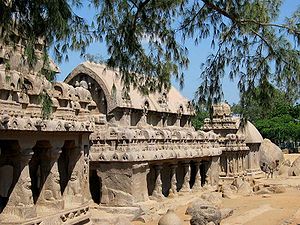Pancha Rathas
| Pancha Rathas | |||||
|---|---|---|---|---|---|
| "Pancha Rathas", "Mamallapuram" or "Five Rathas of Mahabalipuram"
UNESCO World Heritage Site |
|||||

Five Rathas of Mamallapuram (Mahabalipuram) (630–638 AD)
|
|||||
|
|||||
Pancha Rathas (also known as Five Rathas or Pandava Rathas) is a monument complex at Mahabalipuram, on the Coromandel Coast of the Bay of Bengal, in the Kancheepuram district of the state of Tamil Nadu, India. Pancha Rathas is an example of monolithic Indian rock-cut architecture. Dating from the late 7th century, it is attributed to the reign of King Mahendravarman I and his son Narasimhavarman I (630–680 AD; also called Mamalla, or "great warrior") of the Pallava Kingdom. An innovation of Narasimhavarman, the structures are without any precedent in Indian architecture. The complex is under the auspices of the Archaeological Survey of India (ASI) and is part of the UNESCO World Heritage site inscribed by UNESCO as Group of Monuments at Mahabalipuram.
Each of the five monuments in the Pancha Rathas complex resembles a chariot (ratha), and each is carved over a single, long stone or monolith, of granite which slopes in north-south direction with a slight incline. Though sometimes mistakenly referred to as temples, the structures were never consecrated because they were never completed following the death of Narasimhavarman I. The structures are named after the Pancha Pandavas and their common wife Draupadi, of epic Mahabharata fame. In order of their size, they include the Dharmaraja Ratha, Bhima Ratha, Arjuna Ratha, Nakula Sahadeva Ratha, and Draupadi Ratha.
...
Wikipedia




